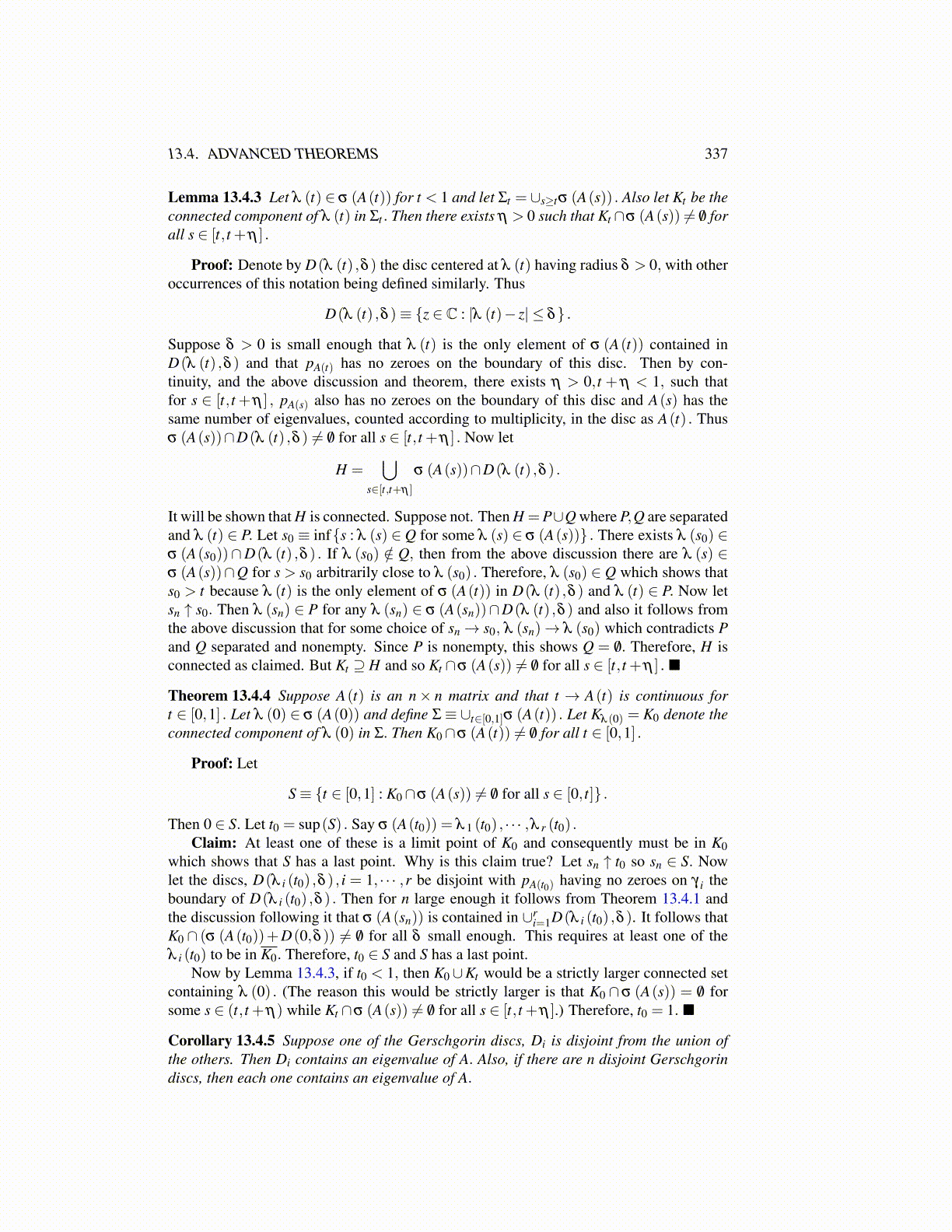
13.4. ADVANCED THEOREMS 337
Lemma 13.4.3 Let λ (t) ∈ σ (A(t)) for t < 1 and let Σt = ∪s≥tσ (A(s)) . Also let Kt be theconnected component of λ (t) in Σt . Then there exists η > 0 such that Kt ∩σ (A(s)) ̸= /0 forall s ∈ [t, t +η ] .
Proof: Denote by D(λ (t) ,δ ) the disc centered at λ (t) having radius δ > 0, with otheroccurrences of this notation being defined similarly. Thus
D(λ (t) ,δ )≡ {z ∈ C : |λ (t)− z| ≤ δ} .
Suppose δ > 0 is small enough that λ (t) is the only element of σ (A(t)) contained inD(λ (t) ,δ ) and that pA(t) has no zeroes on the boundary of this disc. Then by con-tinuity, and the above discussion and theorem, there exists η > 0, t + η < 1, such thatfor s ∈ [t, t +η ] , pA(s) also has no zeroes on the boundary of this disc and A(s) has thesame number of eigenvalues, counted according to multiplicity, in the disc as A(t) . Thusσ (A(s))∩D(λ (t) ,δ ) ̸= /0 for all s ∈ [t, t +η ] . Now let
H =⋃
s∈[t,t+η ]
σ (A(s))∩D(λ (t) ,δ ) .
It will be shown that H is connected. Suppose not. Then H =P∪Q where P,Q are separatedand λ (t) ∈ P. Let s0 ≡ inf{s : λ (s) ∈ Q for some λ (s) ∈ σ (A(s))} . There exists λ (s0) ∈σ (A(s0))∩D(λ (t) ,δ ) . If λ (s0) /∈ Q, then from the above discussion there are λ (s) ∈σ (A(s))∩Q for s > s0 arbitrarily close to λ (s0) . Therefore, λ (s0) ∈ Q which shows thats0 > t because λ (t) is the only element of σ (A(t)) in D(λ (t) ,δ ) and λ (t) ∈ P. Now letsn ↑ s0. Then λ (sn) ∈ P for any λ (sn) ∈ σ (A(sn))∩D(λ (t) ,δ ) and also it follows fromthe above discussion that for some choice of sn→ s0, λ (sn)→ λ (s0) which contradicts Pand Q separated and nonempty. Since P is nonempty, this shows Q = /0. Therefore, H isconnected as claimed. But Kt ⊇ H and so Kt ∩σ (A(s)) ̸= /0 for all s ∈ [t, t +η ] . ■
Theorem 13.4.4 Suppose A(t) is an n× n matrix and that t → A(t) is continuous fort ∈ [0,1] . Let λ (0) ∈ σ (A(0)) and define Σ≡ ∪t∈[0,1]σ (A(t)) . Let Kλ (0) = K0 denote theconnected component of λ (0) in Σ. Then K0∩σ (A(t)) ̸= /0 for all t ∈ [0,1] .
Proof: Let
S≡ {t ∈ [0,1] : K0∩σ (A(s)) ̸= /0 for all s ∈ [0, t]} .
Then 0 ∈ S. Let t0 = sup(S) . Say σ (A(t0)) = λ 1 (t0) , · · · ,λ r (t0) .Claim: At least one of these is a limit point of K0 and consequently must be in K0
which shows that S has a last point. Why is this claim true? Let sn ↑ t0 so sn ∈ S. Nowlet the discs, D(λ i (t0) ,δ ) , i = 1, · · · ,r be disjoint with pA(t0) having no zeroes on γ i theboundary of D(λ i (t0) ,δ ) . Then for n large enough it follows from Theorem 13.4.1 andthe discussion following it that σ (A(sn)) is contained in ∪r
i=1D(λ i (t0) ,δ ). It follows thatK0 ∩ (σ (A(t0))+D(0,δ )) ̸= /0 for all δ small enough. This requires at least one of theλ i (t0) to be in K0. Therefore, t0 ∈ S and S has a last point.
Now by Lemma 13.4.3, if t0 < 1, then K0∪Kt would be a strictly larger connected setcontaining λ (0) . (The reason this would be strictly larger is that K0 ∩σ (A(s)) = /0 forsome s ∈ (t, t +η) while Kt ∩σ (A(s)) ̸= /0 for all s ∈ [t, t +η ].) Therefore, t0 = 1. ■
Corollary 13.4.5 Suppose one of the Gerschgorin discs, Di is disjoint from the union ofthe others. Then Di contains an eigenvalue of A. Also, if there are n disjoint Gerschgorindiscs, then each one contains an eigenvalue of A.